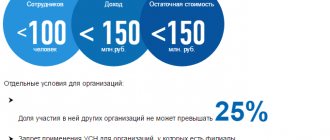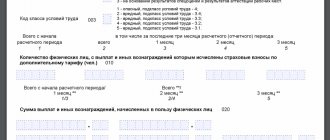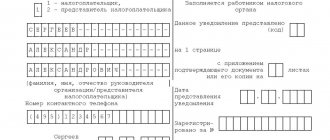All business entities, based on the results of their work, are required to make certain contributions to the budget and trust funds. The amount and frequency of payments is influenced by a number of factors. This includes the nature of the activity and the number of employees involved. The amount of income received plays an important role.
Therefore, the Russian Tax Code provides for several taxation systems, which have both their pros and cons. In this material we will focus on what the OSNO tax system is.
What is the general tax system?
The general taxation system for LLCs and all other business entities is the most standardized, which involves the calculation and payment of a certain amount of taxes.
Its use requires business companies and entrepreneurs to maintain accounting and tax records according to the full scheme. Indeed, with OSNO it is necessary to reflect all the facts of economic activity in order to obtain complete and reliable information necessary for calculating the relevant taxes.
In this case, it is necessary to reflect not only the company’s property, but also the sources of its formation, as well as all the operations that occur with it. These operations are assigned to certain trained personnel of the organization. In the absence of such specialists, the company management assumes responsibilities.
However, you need to understand that in fairly large enterprises the load on the company’s administration will be significant. As a result, it is possible that not all transactions will be taken into account, and this will lead to controversial situations with regulatory authorities and bringing the organization to responsibility.
Existing requirements for business entities operating on the general taxation system guarantee that an enterprise or individual entrepreneur will comply with established legal norms.
In this regard, certain areas of business, in accordance with legislative acts, can only be used by entities using a common system.
It is believed that they have information about the company’s activities in full, so the activities of these entities make it possible to organize full control. Attention: the use of such a system, unlike preferential ones, does not require the company or individual entrepreneur to meet established criteria (volume of revenue received, number of employed employees, etc.).
The legislation provides for the opportunity to switch from this taxation system to other regimes for entities that have recently registered. They are given thirty days to do this. A company or individual entrepreneur on OSNO needs to prepare special applications and send them to the Federal Tax Service.
Payment calculation procedure
If advance payments are established in the region, they are calculated as follows:
1/4 x tax base x tax rate
The tax base for different types of cars will be the number of engine horsepower, kilograms of traction force, registered tons or the vehicle unit itself.
Example:
And again Nizhny Novgorod. The company's balance sheet includes a truck with an engine power of 150 horsepower. For this type of transport, according to local law, the rate is 36 rubles per horsepower.
1/4 x 150 x 36 = 1350 – quarterly payment.
The tax for the year is 5,400 rubles.
How to calculate if this truck was not owned for the whole year, but only for part of it? You need to divide the number of months of ownership by 12. Multiply the calculated tax amount by the resulting coefficient. If the month is incomplete, then it is considered full if the vehicle was registered before the 15th (upon acquisition), or deregistered after the 15th (upon disposal). Otherwise, the month is not counted at all.
Example:
The same truck in the same Nizhny Novgorod. The organization acquired and registered it on May 17, 2021. May is not taken into account, which means we calculate the tax for 7 months.
Amount for the year:
150 x 36 x 7/12 = 3,150 rub.
To calculate the advance for the second quarter, you need to take a coefficient of 1/3, where 1 is the number of months of ownership in the first quarter (we do not count only June, May), 3 is the number of months in the quarter.
1/4 x 150 x 36 x 1/3 = 450 rub.
The advance for the second and third quarters is calculated in the usual way, without a coefficient.
In what cases is it beneficial to use OSNO?
Currently, the registration of an LLC or the registration of an individual entrepreneur is accompanied by a change in the applicable taxation regime to some preferential system.
However, it must be taken into account that the general taxation system for individual entrepreneurs or organizations may be more profitable than other regimes.
Practice has developed such that the general regime is used in most cases by large businesses. Therefore, if such enterprises are the organization’s partners, then it also needs to apply OSNO.
This situation is explained by the fact that the main tax payment on OSNO is VAT. This is an indirect payment to the budget, which is included in the price of the product paid by its consumer. The subject, on the one hand, calculates this tax on its products, on the other hand, it transfers the amount of this tax as part of the cost of goods, works and services.
The rules of law enable the taxpayer to reduce the amount of his VAT by the input VAT that organizations and individual entrepreneurs transferred to their suppliers and contractors. However, if the partner is an entity with a preferential tax system where there is no VAT, then the company will not be able to apply a VAT deduction
The rules of law establish the types of activities for which a strictly defined tax regime - OSNO - must be applied. These are primarily insurance companies, credit institutions, and pawnshops. Therefore, the general regime can be considered a pass to these areas of activity.
Current legislative acts establish the obligation of companies and individual entrepreneurs to charge VAT when importing goods into the territory of our state. And only OSNO taxpayers have the opportunity to take these amounts into account when refunding VAT.
Attention: if an organization receives a loss for the year, then profit tax does not need to be calculated. In many preferential systems, if performance indicators are negative, the payment established by the standards must still be made. For example, on the simplified tax system “income minus expenses” there is a minimum tax of 1%, which you will have to pay in any case.
For them, either the tax is calculated from conditional income, or there is a minimum tax that the company is obliged to pay anyway at the end of the year.
Legal norms provide some benefits for entities operating at OSNO. This may be the possibility of reducing the number of reports submitted, the frequency of this action, or exemption from tax (for example, from VAT). In this case, you only need to meet certain criteria.
In this regard, a business entity can reduce the tax burden to a level that can be even more beneficial than the preferential system.
Attention: In addition, OSNO can be combined with another taxation system that applies to one of the types of activities.
Features of OSNO
The main feature of the general taxation system is that its subjects pay the majority of taxes provided for by law.
If under other schemes (STS, UTII) either a percentage of revenue or a fixed amount is paid, then within the OSNO, each of the taxes established by law is paid separately.
Simplified taxation options are characterized by the fact that all existing tax return forms are replaced by one, which, in principle, is not difficult to fill out.
Within the framework of OSNO, you have to submit your own reports for each tax, fee, contribution. Depending on the type of payment, it is provided monthly, quarterly, semi-annually or annually.
If, within the framework of simplified systems, a specific payment date is established, then for taxes that form the OSNO, there are their own deadlines for settlements with the budget. Therefore, it is important for the accountant not to miss anything, because otherwise the company will face serious sanctions.
The use of OSNO is mainly typical for large enterprises whose turnover amounts to tens of millions of rubles. Then there will be no hassle regarding the maximum amount of revenue and the maximum number of personnel.
What types of activities can only be carried out on a common system?
The current legislation defines certain types of business that can only be carried out by business entities applying the general regime.
They include:
- Operation of pawnshops;
- Activities related to issuing loans;
- Insurance activities;
- Operation of non-state pension funds;
- Operation of investment funds;
- Work on the implementation of gambling;
- Work on the production and sale of excisable goods (alcoholic beverages, fuel and others);
- Extraction and sale of minerals;
- And others.
Taxes and reporting on the general taxation system
Let’s take a look at what the general taxation system for individual entrepreneurs includes: what taxes need to be paid, table. Typically, similar taxes apply to companies.
When using this system, you need to remember that even if no activity was carried out during the reporting period, you will still have to submit reports with zero indicators. If the “zero” declaration is not sent within the specified deadline, then this will be regarded as failure to submit, and the organization will be subject to a minimum fine.
In addition, a single declaration is provided for business entities, which can replace several zero ones. But it is allowed to be used only if during the reporting period no transactions were carried out in cash at all (including charging a commission for maintaining a current account or making erroneous payments).
Taxes and reporting of individual entrepreneurs on OSNO
| Tax name | Tax transfer | Reporting |
| VAT (basic rate 18%, from 01/01/2019 - 20%) | Up to the 25th day of each month of the quarter in equal shares based on the calculated tax according to the declaration | Reporting is provided for each quarter according to the following deadlines: until 25-04 until 25-07 until 25-10 until 25 -01 |
| Personal income tax (basic rate 13%) | Advance transfers for yourself: For the 1st half of the year - until July 15 9 months before October 15 For the 4th quarter - until January 15 For the year - July 15 | Report 3-NDFL at the end of each year until 30-04 |
| Property tax for individuals (set by the municipality) | Regulated by the municipal administration. Usually transferred before December 1st at the end of the reporting year. | Reporting is not completed |
Taxes and reporting of LLC on OSNO
| Tax name | When to transfer | What reports to submit |
| VAT (basic rate 18%, from 01/01/2019 - 20%) | Up to the 25th day of each month of the quarter in equal shares based on the calculated tax according to the declaration | Reporting is provided for each quarter according to the following deadlines: until 25-04 until 25-07 until 25-10 until 25 -01 |
| Income tax (rate 20%) | Until the 28th day after the end of each quarter or month. The remainder of the tax for the reporting year is paid until March 28. | Quarterly form or monthly form for determining advance tax payment until the 28th day after the end of the reporting quarter or reporting month. |
| Organizational property tax | Each subject of the country determines its own tax payment deadline. As a rule, this is before the 5th day after sending the advance payment calculation (before 05.05, before 05.08, before 05.11). For a year, the period is usually determined until the 10th day after sending the annual declaration (10.04) | The annual declaration is submitted by March 30 at the end of the reporting period. In regions of the country there may be advance payments with a due date before the end of the month, after the end of the quarter. |
Reporting of individual entrepreneurs and LLCs for employees
| Tax name | When to transfer | What reports to submit |
| Personal income tax (basic rate 13%) | If a salary is issued, then the tax payment must be made the next day after this event. If sick leave or vacation pay are issued, then the tax on them must be transferred in a single amount at the end of the month | Form 6-NDFL is sent quarterly: until 30-04, until 31-07, up to 30-10, until 31-03 Form 2-NDFL is sent once a year: until 01-04 |
| Transfers to social funds (PFR basic rates 26%, Compulsory Medical Insurance Fund 5.1%, Social Insurance Fund 2.9%) | Contributions must be made by the 15th day of the month following the month of payroll. | Calculation of insurance premiums by terms must be sent every quarter: 1st quarter - until 30-04 1st half of the year - until 30-07 for 9 months - 30 -10 per year - until 30-01 |
| Payments for industrial accidents | Contributions must be made by the 15th day of the month following the month of payroll. | Form 4-FSS is sent every quarter: until 25-04 until 25-07 until 25-10 until 25 -01 |
In addition to the reports mentioned above, a business entity subject to the general tax regime must submit the following reports:
- Information on the average payroll number - it must be sent to the Federal Tax Service before January 20 of the year that follows the reporting period;
- The SZV-M report is monthly and must be submitted to the Pension Fund before the 15th day of the month following the reporting one.
- The SZV-STAZH report is an annual form for the PF; it must be submitted before March 1 of the year following the reporting year.
Value added tax next year
Changes in tax legislation also affected the fee, the payer of which is companies selling any product. Despite the fact that they are responsible for paying value added tax, indirectly the entire burden falls on the shoulders of tax payers. The fact is that the products on which additional costs are imposed are purchased by ordinary citizens. Knowing this, companies selling goods include in the cost of products not only their own surcharge, but also the amount of tax due.
Let's take a closer look at how and who will be affected by the VAT innovations.
The most stunning news regarding the changes in this area is that as 2021 approaches, some purchasers will be forced to play the role of tax agents.
This applies primarily to goods represented by scrap metal, that is, to:
- used aluminum and other metals with their alloys;
- non-ferrous and ferrous metal waste;
- raw skins of skinned animals.
All of the listed types of goods in our country were previously exempt from paying the required tax fee, however, now the person purchasing them is obliged to calculate value added tax. However, this rule does not apply to ordinary individuals, but to individual and legal entities that acquire the above names.
In addition, some intermediary companies are excluded from the list of tax agents. These include:
- telecom operators, the list of which is listed in the Federal Law on the Russian payment system;
- subjects of the national payment system.
There are three main rates for value added tax:
- the standard rate is 18% of the markup on the product;
- if the transaction performed is excluded from the list of those subject to 18% taxation, then the rate will be 10%;
- in all other cases the rate will be 0%.
The requested tariffs remain the same and continue to apply.
In addition, from the first of January of the next year, tax payers forever lose the right to receive a deduction in the form of input VAT on those categories of goods that were purchased using public funds.
As for operations carried out for the sale of re-exported goods, in 2021 the rate on them is reduced to zero. However, only on the condition that the goods have already undergone all customs procedures specified by law.
In addition, a much larger number of people have acquired the right to receive VAT at a zero rate. It will also be possible to waive the zero rate for the required tax levy on exports in the coming 2021.
Changes in tax legislation will affect all Russian citizens
Is it possible to combine OSNO with other taxation systems?
According to the law, it is allowed to use OSNO in conjunction with other preferential regimes, but if their types of activities do not overlap.
Companies can simultaneously use the general regime and imputed tax. In addition to imputation, the patent system is also available to entrepreneurs.
Attention: When combining several systems, it is imperative to organize separate accounting of incoming income, expenses incurred and property used. It is prohibited to combine it with the simplified system, as well as with the agricultural tax.
Taxation of individual entrepreneurs in 2021
The Ministry of Finance of the Russian Federation has developed a number of changes in the field of taxation for another category of the population, represented by individual entrepreneurs.
For those who have chosen a simplified taxation system, a maximum annual limit on incoming income has been introduced. It should be noted that the limit is very acceptable: it is 150 million units of Russian currency. According to statements by representatives of government agencies, the required limit will be valid directly from 2021 to 2021, that is, its relevance will last two years. The rates for the tax collections under consideration all remained the same, but the authorities of the regions of the Russian Federation, as before, received the right to reduce their value.
Each case will be considered individually
The funds received as a pension for each individual entrepreneur in 2018 will amount to a little more than 24 thousand Russian rubles. They will have to be paid to the state without fail. For medical insurance, the payment amount will be 5 thousand units of Russian currency.
Now government structures are working to consider a legislative project that involves exempting the entrepreneurial layer of the population from payments directly related to the minimum wage (minimum wage), which increases annually. However, the application of the required bill will be largely disadvantageous for people building their own businesses, so its adoption will most likely not take place.
What taxes does an individual entrepreneur pay on the simplified tax system?
The article will be useful to those who are just thinking about starting a business, as well as citizens who are afraid to work legally for fear of exorbitant tax fees.
The procedure for switching to OSNO from other tax regimes
Transition from simplified tax system to OSNO
A business entity has the right to stop using the simplified system and switch to the general regime if the following situations arise:
- On a voluntary basis, switching from one system to another is allowed from January 1 of the new year.
- Forced - this transition is made when one of the criteria for using the simplification has been violated - income has been exceeded, the total cost of fixed assets, the number of employees, branches have been organized, etc. It is necessary to switch to the general system and recalculate all taxes from the beginning of the quarter in which a violation has occurred.
If changes to tax systems are made voluntarily, then you must send a form in format 26.2-3 to the Federal Tax Service. This must be completed before January 15th of the year.
Attention: if the transition is forced due to a violation, then you need to use the form in form 26.2-2. It must be sent before the 15th day of the month that follows the quarter in which the violation was detected. The taxpayer himself must monitor these indicators.
Transition from UTII to OSNO
You can make the transition from UTII to OSNO at the personal request of a business entity, or if the activity that was subject to the imputed tax was discontinued.
There are also several reasons why a business entity may refuse imputation:
- This type of activity is no longer included in the imputed tax;
- The subject violated one of the mandatory rules for using UTII;
- The subject began to operate as a simple partnership, or in the form of managing someone else's property.
Also, the company is obliged to immediately switch from the imputed tax to the general system if another company acquired any share in its authorized capital.
Attention: the Tax Code defines the time frame within which a business entity must notify the tax authority of the termination of the application of the imputed tax. For companies, the UTII-3 form is provided for this purpose, and the entrepreneur must use the UTII-4 form.
Transition from Unified Agricultural Tax to OSNO
The agricultural tax is designed for business entities of all types that carry out work in the field of agriculture. At the same time, fairly strict rules for its use are defined for the system. If a business entity violates at least one, it will automatically be deprived of the right to apply agricultural tax and will have to switch to the general system, recalculating tax payments from the beginning of the year.
The main indicator by which the right to use this system is determined is the output of crop or livestock products. At the same time, in total revenue, proceeds from the sale of own products must have a share of at least 70%. In addition, a business entity must produce agricultural products - simple processing of raw materials is unacceptable.
If a violation is recorded according to one of the specified criteria, but the subject must independently begin to apply the general system, recalculate all tax payments from the beginning of the calendar year, and within 1 month send a notification to the tax authority that it can no longer apply agricultural tax.
Attention: you can return from the general regime back to the unified agricultural tax only after 1 year has passed from the date of loss of the right to use.
A company or entrepreneur has the right to independently refuse the agricultural tax and begin to apply the general system. To do this, before January 15 of the year, you must submit an application on form 26.1-3 to the tax authority.
Transition from Patent to OSNO
You can switch from the patent system to the general one either on your own initiative or without fail, due to non-compliance with the current conditions for being on the PSN.
Such criteria include:
- The number of employees who can be hired has been exceeded. For this system, it is permissible to hire no more than 15 people;
- The total amount of income received by the entrepreneur since the beginning of this year has exceeded the level of 60 million rubles.
In previous years, another criterion was in force, in case of violation of which the entrepreneur was automatically transferred to the general regime - if the patent was not fully paid within the specified period. Now this rule has been canceled - fines will be imposed on individual entrepreneurs for violating the deadline for paying taxes, but the right to use the patent system will remain with him.
Attention: if an entrepreneur decides to leave PSN and start working with OSNO, then he needs to fill out an application in the established form within five days from the date of transition.
Tags: Tax regimesOSNO
Land tax in 2021
The cost of land plots in the coming year will also be assessed according to the cadastral characteristics. To do this, it is necessary to estimate the market value of the site. Unfortunately, there is an opinion among taxpayers that the cost assessment by bureaucrats is often biasedly inflated. The price is determined by the cadastral chamber and its specialists. Their decision regarding the determination of the price of the plot can only be challenged in court. However, there is a real danger of losing and incurring losses associated with paying for the costs associated with the trial.
The amount of payment due to the state in 2021 will increase by as much as 20%, and its growth will continue immediately until 2020. The main argument of government structures in favor of such an increase is the assumption that the filling of regional budgets, increased through transfer to cadastral value, will have a very positive effect on the development of the infrastructure of each residential locality.
By the way, this filling will increase approximately 6-8 times








